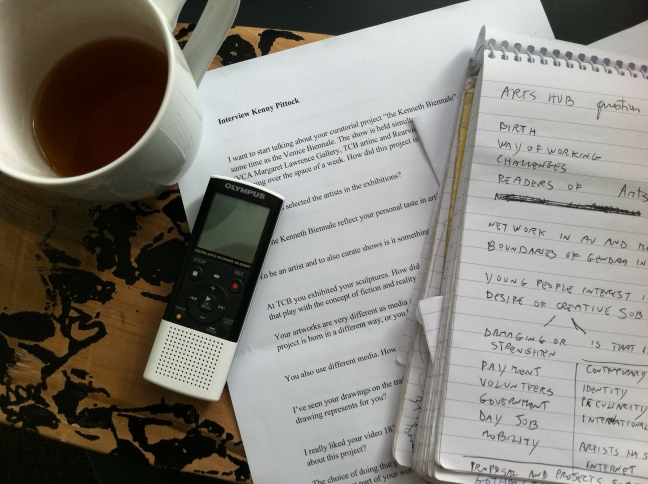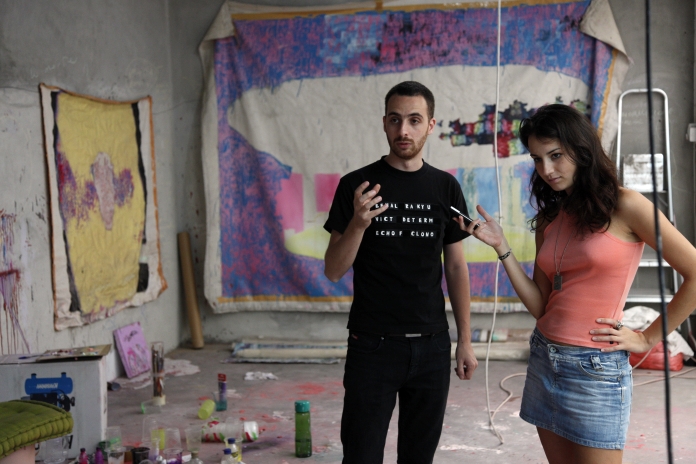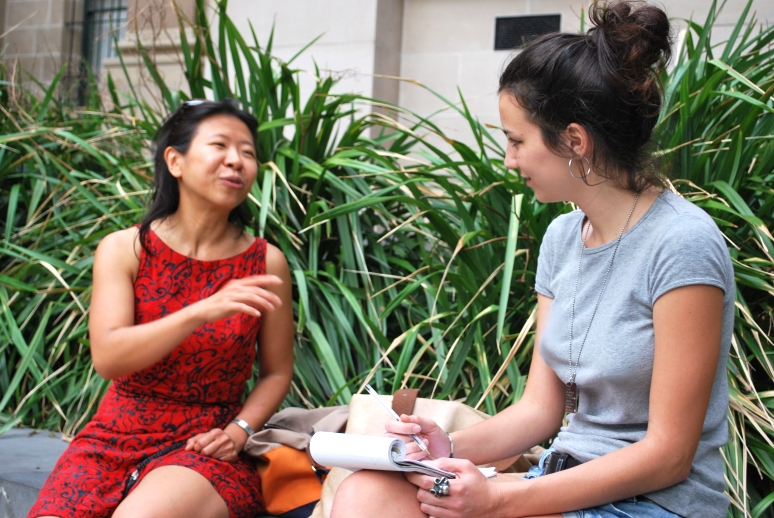How to interview an artist

I just came back from my 32nd interview for my reportage in Australia, so I finally feel like I can tell my opinion about how to interview an artist.
The first thing you have to do is obviously contact the artist and you usually do that through her/his mail on her/his personal website.
The first mail has to be a quite formal style, without exaggerating though.
You have to be short and clear, explaining the artist why you want to interview her/ him and what aspects of her/his work are you interested in.
If your interview is part of a bigger project, like a reportage, spend a few words to inform the artist about it.
Don’t forget to explain her/him if this is your own project or if you are working for a magazine.
In this last case it would be nice to put a link to the website of your magazine, so the artist can have a look.
Put also your own website or blog in the signature, along with your personal page on a web magazine that hosts your work, if you have one.
That would give you credibility and would also give the artist the possibility to take a peek at your style and at the kind of articles you usually write.
The next mails would probably me more informal. At this point you can get rid of all the links in your signature, the “best” and “regards” and sign with just your given name.
In your second mail you can suggest the artist a place where you can have the interview.
The most common places are the artist’s studio, a nice and quite café, the space where the artist has currently a show or the gallery that represents him.
Give options to the artist. To meet her/him in his studio would be ideal – you can guess much more from the artist’s natural habitat than from outcomes of a simple conversation.
Of course, you can suggest to meet in the studio, but not all the artists have one and not everyone is happy to let a suspicious journalist or art critic in. If the artist tells you that his studio is empty or messy at moment, just don’t bother. Above all don’t insist.
If you are doing the interview in your own city, you probably would know the most quiet and suitable cafe for an interview. If you are abroad don’t be shy, just ask the artist if he knows a nice cafe to meet.
The choice would probably tell you something about the artist lifestyle and tastes.
In any case discover new places in a new city is always exciting.
To meet in the gallery where the artist has his own exhibition is good because you can have her/him explaining you her/his works directly. An awkward situation is not unlikely though – not all the artists are happy to give tours of their own show – after all there is a reason why they have decided to express themselves with art and not with words.
Again, the safer choose is to let the place to meet up to the artist.
Once you have fixed the place and the time, drop your phone number in your last mail – probably the artist will do the same – and get ready for the interview.

Obviously you have already studied the subject matter (If you have not and you don’t exactly know how to prepare an interview, have a look at this article).
If you meet the artist in a café try your best to be just few minutes early, so you can sit and settle down with your recorder and notebook. Moreover you can take advantage of this extra time to have a last look at the questions that you printed down.
Even if you have to know already what to ask to the artists, it’s better to have your questions printed.
As much as it looks professional to have your questions on your tablet, try to not rely too much on electronic devices.
In my opinion an actual piece of paper will always be more reliable that a screen, but yeah, maybe it’s just me. You certainly need a recorder and that’s already quite enough of technology for the day.
You can’t write down the artist’s answers for the same reason you shouldn’t read the questions that you carefully wrote down at home: Eye contact and conversation flow are more important that good-formulated questions.
That doesn’t mean that every now and then you can’t rapidly write down some notes for new further questions out of what the artist is telling you. To latch on the artist’s statements will make the conversation more fluid.
That’s what you are trying to do: a conversation, not an interrogatory.
Make the artist feel at home, let him indulge on anecdotes and useless details. You will found out that these are the things that make an interview.
You have to be able to go to the core of subject matter, the artist’s work, and at the same time you have to be able also to catch every detail and every quirk of the artist’s personality.
It’s not easy to have this double focus, but in the end it’s just conversation practice.
If you want the artist to behave naturally you don’t have to be too neutral.
Of course, be confident in posing your questions, but don’t hide your own personality behind your professional attitude.
Say a little bit about yourself and your experiences. That will help the artist to see you not as a dreadful journalist but as a regular gal/guy.
Before starting the actually interview try to make some random conversation.
Ideally the interview would just flow from your chat, but of course, you can’t always have a good chemistry.
At a certain point you have to put your recorder on the table. Try to be as casual as possible, and don’t forget to always ask:” Do you mind if I record?”. Not everyone is always ok with it.
Sometimes it’s difficult to chose when to put out your recorder from your bag, especially if you are walking around in the artist studio following the artist’s explanation.
My suggestion is to be bold and don’t worry if you could sound like coming out of the blue.
Don’t wait for the “right moment”. Your aim is to catch and bring home as much as possible, and sometimes you have the best quotes right when the artist is talking loosely about his artworks.
At the same time don’t be anxious to record everything.
The sensation that the artist is firing his best shots in the first two sentences after introducing himself would always be present. Don’t try to stop him going: “Maybe we will talk about that later in out interview…”. That will just create awkwardness.
If you are there trying to make interviews you suppose to have a good memory, isn’it?
Get to smartly drive the introductory conversation on general themes, but keep in mind what the artist was saying on that particular subject of which you want to talk afterwards.
You can come back there later during the actual interview with a relaxed:”… As you were saying before…”.
Try to be as natural as possible. Don’t just ask questions but also say your opinions about his artworks. Show that you know his work and that you have also have favourites artworks in her/his production.
The end of an interview you are very likely to be clumsy. Try to avoid that.
For starters give signals to the artist that the interview is going to end soon, something like “ok, just one last question…”.
At the end of course thank the artist for his time, and reassure her/him telling about the most interesting points of the interview and your new discoveries about his work.
If you need hot a picture of the artist for the magazine, or you need further images of his work from him, that is the right moment to ask.
Give her/him information about when the interview will be published, and have a short last conversation.
Now you are done with your interview. Once at home comes the most boring part ever: transcribe it from the recording. But that one is, luckily, another story.

The pictures above are from my interview with the artist Marco Cassani in Bali and with the artist Tintin Wulia in Melbourne



